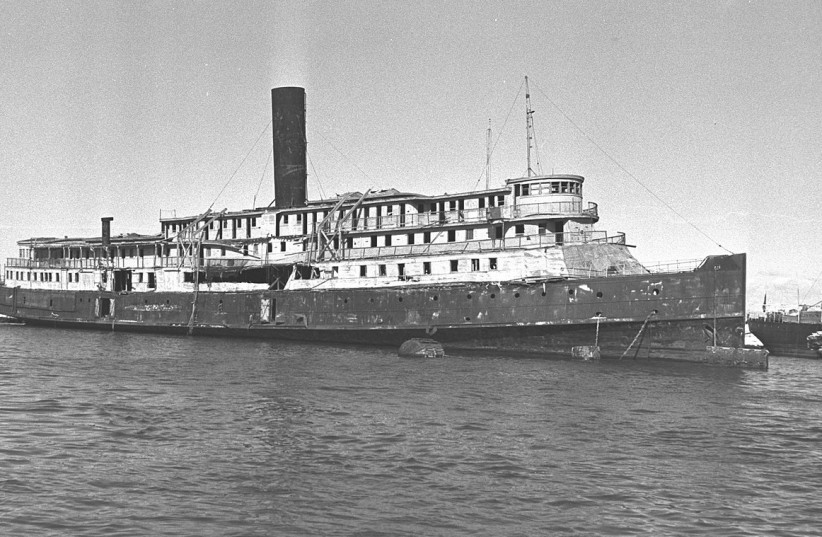July 11, 2022 marks 75 years since the ship SS Exodus 1947 set sail from the French port of Sète, carrying 4,515 Jews, most of whom were Holocaust survivors, to bring them to Mandatory Palestine, the future State of Israel as part of Aliyah Bet.
The ship itself, formerly known as President Warfield, was an inland steam packet ship built as a freighter and passenger carrier in 1928 for use in Chesapeake Bay before being used as a training ship for the British army during World War II. Here, the ship saw two trips across the Atlantic and even saw clashes with the Nazis.
 Learn how to buy your home in Israel with confidence
Learn how to buy your home in Israel with confidenceBut its journey from France to the Holy Land, during which it was renamed to Exodus 1947, has become an arguably its most enduring legacy and cemented its place in Jewish history.
<br>Background: Aliyah Bet, the Holocaust and illegal Jewish immigration
The period between 1920 and 1948 saw a wave of Jewish immigration to Mandatory Palestine. However, it was divided into two distinct names, Aliyah Aleph and Aliyah Bet. The former refers to the limited, legal Jewish immigration into the mandate that was approved by the British.
Aliyah Bet (also known in Israel as Ha'apala, meaning ascension), however, was entirely illegal, trying to get around the restrictions the British implemented.

These restrictions got worse in 1939, after the British implemented the White Paper that limited immigration, and subsequently saw more prospective Jewish immigrants to try and enter Mandatory Palestine illegally.
And after 1939, this only became a more pressing issue.
The rise of Nazi Germany and the start of World War II saw antisemitism and imminent danger for European Jewry skyrocket, prompting many refugees to attempt to flee.
Doing so legally was met with mixed results, and there are many infamous moments of Jewish refugees being refused by every country they attempt to flee to.
Ultimately, the Holocaust saw the widespread extermination of millions of Jews around the world, and to many, this signaled the end of Jewish life in Europe and saw a number of Jewish Holocaust survivors hoping to flee Europe to Israel.
One ship's incredible and unexpected journey
According to historian Alexander Crosby Brown, President Warfield had its fans. He noted that this ship, intended originally to just ferry around Chesapeake Bay, had done the unthinkable, being thrust into World War II not only as a training barrack for British troops but also for having been embroiled in clashes with the Nazi forces.
After the war, however, it was moored in the Jams River, though some did rush to view it and even take pictures.
But soon, everything would change.
As noted by the US Department of Navy records, President Warfield was purchased by the Washington-based Potomac Shipwrecking company in 1946. This was for a relatively low price, just $8,028.
"Those who had known and loved the old ship groaned in view of the ignominious fate that apparently awaited her as she was towed away from the James River."
Alexander Crosby Brown
As recounted by Brown, "Those who had known and loved the old ship groaned in view of the ignominious fate that apparently awaited her as she was towed away from the James River."
But just a couple days later, it was purchased for $40,000 by the New York-based Weston Trading Company, an enigmatic firm unlisted in phonebooks that only had a one-room office in Manhattan.
But here was good reason for this.
According to several accounts, the Weston Trading Company was a front company for the pre-state Zionist militia the Haganah. In fact, this company was also known to have purchased other ships for the Haganah, including the former US Coast Guard ship Northland, which would also work to bring Holocaust survivors to Mandatory Palestine in Aliyah Bet and which later became Eilat A-16 and then Matzpen, the Israeli Navy's first warship.

The funding to purchase President Warfield allegedly came from Zionists from Baltimore. After its purchase, it was given over to the Haganah branch in charge of the illegal Jewish immigration operation, Mossad LeAliyah Bet. Here, it underwent at least $125,000 worth of repairs, modification and overhaul for the planned voyage.
Why was this ship chosen? According to historian Aviva Halamish, the reason was rooted in President Warfield being sturdy, fast, able to withstand ramming and being taller than British Navy destroyers, meaning it could resist boarding.
The ship was modified to resist boarding, with pipes that could spray steam and boiling oil and wires being implemented to protect from boarding.
In 1947, it was time to set sail, and the ship sailed to France.
Overall, more than 60 ships attempted to take illegal Jewish immigrants to Mandatory Palestine during Aliyah Bet with mixed results. But Exodus 1947 was the largest, carrying more Jewish refugees than any other. Despite having been built to carry 400 passengers along with 50 crew, 4,515 passengers were stuffed aboard with hundreds of crew. Their goal was to reach Haifa, but it wouldn't be easy.
From the start, there were issues. The British had placed the ship under surveillance from the start and pressured the port not to provide a pilot to navigate out of the narrow passages, despite a pilot having already been paid a million francs and promised another million. As such, Yitzhak "Ike" Aronowicz, captain of the soon-to-be-renamed Exodus 1947, had to sail alone, improvising tricky maneuvers to avoid crashing into a seawall.
But shortly after, a British cruiser and a destroyer convoy arrived in the Mediterranean Sea, chasing after them for several days.
The crew were well aware of this. According to David Ariel, who was a passenger aboard the ship, a plan was devised to get them ashore in Israel by getting close enough to the shore so the passengers could jump into the sea with life belts to swim to the shore.
Ultimately, the British ships stopped them when they were just 40 kilometers away from the shores of Mandatory Palestine and stormed the ship and a violent brawl between them and the ship's crew and passengers ensued.
"On our last night, the British ships came in one at a time, rammed us, threw tear gas bombs and stun grenades, and succeeded in getting a large party of club-swinging marines on board. Three people were killed, including our second mate Bill Bernstein. Over a hundred were injured. By daybreak, we surrendered and were towed into Haifa."
Avi Livney
"On our last night, the British ships came in one at a time, rammed us, threw tear gas bombs and stun grenades, and succeeded in getting a large party of club-swinging marines on board," recounted Avi Livney, one of the ship's crewmembers.
"Three people were killed, including our second mate Bill Bernstein. Over a hundred were injured. By daybreak, we surrendered and were towed into Haifa."
The passengers were brought to Haifa and split up between British ships to be taken to Cyprus, after which they would be sent to Europe, specifically to German camps in Hamburg.
But the story didn't end there. In fact, the story of Exodus 1947 is credited with having help shifting world opinion on the plight of the Jewish refugees, and helped advance the political struggle against the British occupation.
Many of its passengers would also later fully immigrate to Israel, some of whom would tragically die in Israel's wars.

<br>Legacy and the fate of the ship
The story of the Exodus 1947 has been cemented as one of the most dramatic moments of the Aliyah Bet movement during the British mandate era and has even been immortalized in a memorial outside the Haifa Port's International Cruise Ship Terminal in 2017 and a plaque dedicated in 2019 by Keren Kayemeth LeIsrael-Jewish National Fund (KKL-JNF) in the Ofer Forest, not too far from the Haifa shore where the British had towed the ship in the first place.
The ship itself remained moored, damaged in Haifa for years, with no one wanting to buy it.
In 1952, an unexplained fire broke out on the Exodus 1947, irreparably damaging it. It was later towed near Shemen Bach and scuttled.
A few relics have been salvaged and sent to the US, and many attempts have been made to salvage the rest of the wreck, but these have all been unsuccessful thus far, with one attempt even at first succeeding before it sank mid-towing.
Efforts continue, even if extensions of the Haifa port may have inadvertedly been built on top of it. As such, it seems the legacy of the Exodus 1947, a ship with such an incredible story throughout its lifespan, may now rest beneath the waves off Israel's shores, the destination of its final voyage.
Mark Schulman, Maxine Liptzen Dorot and KKL-JNF contributed to this report.
 Sign up for our newsletter to learn more
Sign up for our newsletter to learn more 